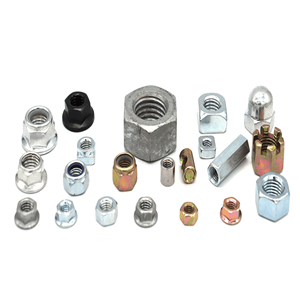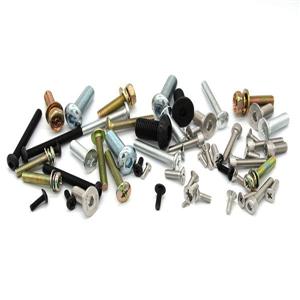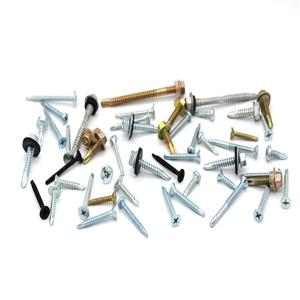Hydrogen embrittlement of alloy steel bolts (2)
3 Materials, hydrogen content and hydrogen embrittlement fracture
3.1 Threshold value of hydrogen embrittlement of materials
The material must contain a sufficient amount of hydrogen so that the microcracks in the material can continue to expand and extend. However, because the hydrogen content is closely related to the other two elements, it cannot be said that hydrogen embrittlement will occur after the hydrogen content reaches a certain value, nor can it be said that hydrogen embrittlement will not occur when the hydrogen content meets a certain value. In other words, a certain hydrogen content can cause hydrogen embrittlement fracture of high hydrogen embrittlement sensitive materials, but it may cause hydrogen embrittlement fracture of low hydrogen embrittlement sensitive materials. In other words, the threshold value of hydrogen embrittlement of different materials is different.
Some people believe that hydrogen embrittlement fracture will occur when the hydrogen content in steel reaches 5 ppm to 10 ppm (5×10 -6 to 10×10 -6), but in fact, even if it exceeds 10 ppm (10×10 -6), it may not be Hydrogen embrittlement fracture must occur; and hydrogen embrittlement fracture may occur even if the hydrogen content is between 1 ppm and 2 ppm (1×10-6~2×10 -6). This is because hydrogen content is not the only factor that causes hydrogen embrittlement fracture. As long as it is highly concentrated in the sensitive stress concentration area or material defect area, it will cause enough pressure to break the material, and the sampling during hydrogen measurement is generally not in the pressure concentration area or material defect area of the material. Therefore, for alloy steel materials, the method of controlling hydrogen content to prevent hydrogen embrittlement fracture is of little significance.
3.2 Ultimate static tensile stress borne by the material
Stress is the driving force for the expansion and extension of micro-cracks in the material, and it depends on the stress experienced by the material. If the material is not subjected to external stress (such as a bolt that is placed but not loaded), hydrogen embrittlement fracture will generally not occur even for sensitive materials with high hydrogen content. The greater the stress, the faster the growth rate of microcracks and the shorter the time for delayed fracture to occur. Since the growth of microcracks takes a certain amount of time, the stress must be static or applied slowly.
The stress mentioned here must be tensile stress, not compressive stress, and the stress generated by static load or slowly applied load. This tensile stress includes not only the tensile stress when the material is subjected to an external load, but also the residual tensile stress generated by the material during machining and heat treatment.
4 Affect the process of hydrogen absorption and removal of alloy steel bolts
ISO 4042:1999 "Fastener Electroplating Layer" Appendix A stipulates: in the heat treatment, gas carburizing, cleaning, packaging, phosphating treatment, electroplating, autocatalytic treatment process and in the working environment, due to the negative effect of cathodic protection, or The reaction of corrosion, hydrogen may enter the substrate. During processing, hydrogen may also enter, such as thread rolling, scorching due to improper lubrication during machining and drilling, and welding or brazing processes. It can be seen that in the whole process of bolt manufacturing, there is the possibility of hydrogen absorption, or there is a process that affects hydrogen absorption.
Combined with the manufacturing process of alloy steel bolts, the main way for hydrogen to enter the alloy steel matrix is electroplating, followed by pickling. In addition, the main process that affects hydrogen absorption is heat treatment.
a) Electroplating is one of the most commonly used surface treatment methods for steel bolts, and it is also the main way for bolts to absorb hydrogen. The electroplating process is a process of cathodic electrodeposition. During electroplating, the coating material (take zinc plate as an example) is used as the anode, and the plated part is used as the cathode. Under the action of a strong current, the positively charged plating metal ions (such as Zn ++) will leave the anode metal plate, move to the part to be plated (as shown in Figure 4), and deposit on the surface of the plated part to form a compact Bright electroplating layer. While forming the deposited layer, the hydrogen ions (H+) in the acid bath will also move to the cathode to be plated parts under the action of the current. Most of the hydrogen ions gathered on the surface of the cathode combine to form hydrogen molecules and overflow, while a part of them penetrates into the matrix material under the strong action of the voltage. Due to the low affinity between iron atoms and hydrogen, the hydrogen entering the matrix often exists in the alloy steel in the form of ions, and is free in the material according to the rules described above.
b) Surface chemical oxidation (commonly known as "blue" or "black") itself will not cause excessive hydrogen absorption and cause hydrogen embrittlement and cracking, but the "pretreatment" of chemical oxidation generally requires pickling. If the pickling is not controlled properly, it will cause hydrogen embrittlement. The so-called pickling is to immerse the heat-treated parts in a weak acid solution for a certain period of time to remove the scale, rust and other dirt caused by the heat treatment. During pickling, the hydrogen ions and hydrogen atoms in the weak acid will also penetrate into the material matrix, but because there is no current action, the hydrogen that penetrates into the material matrix is quite limited, which generally does not cause hydrogen embrittlement and fracture. However, if the material is extremely sensitive to hydrogen embrittlement (such as ultra-high-strength steel and spring steel), the acid concentration in the bath is high, and the immersion time is too long, a lot of hydrogen will penetrate into the material matrix, which will cause hydrogen embrittlement. .
c) The heat treatment (usually quenching and tempering) is carried out at high temperatures. In order to prevent the surface of the bolt from oxidizing during the heat treatment, atmosphere protection is often used. If the protective atmosphere contains hydrogen compounds (such as methanol, methane), or the quenching medium contains hydrogen compounds, it is possible to absorb hydrogen during the heat treatment. The residual stress of the bolt after heat treatment has a very obvious effect on hydrogen embrittlement. If the residual stress is not eliminated, the bolt is more likely to absorb hydrogen and it is more difficult to remove hydrogen.
Hydrogen removal, also known as "drive hydrogen", uses the reversibility of hydrogen free in metal to remove hydrogen from hydrogen-sensitive materials. When removing hydrogen, the bolts after electroplating and before passivation are heated to a certain temperature and kept for a period of time, so that the hydrogen in the material gathers to form hydrogen molecules and escape. Factors affecting the effect of hydrogen removal: one is the time interval between the completion of electroplating and the beginning of the removal of hydrogen; the second is the temperature of hydrogen removal; the third is the time of hydrogen removal. Generally speaking, the more timely hydrogen removal after plating, the higher the hydrogen removal temperature, and the longer the hydrogen removal time, the better the hydrogen removal effect.




